Dogfish Head’s origin story
When Sam Calagione and his wife Mariah founded Dogfish Head Craft Brewery, they started the smallest brewery in America in one of the smallest states in America. In 1995 Dogfish Head Brewery co-existed with Dogfish Head Brewing & Eats in a small storefront in Rehoboth Beach, Delaware. Sam was the head brewer and he made beer 13 gallons at a time. In his beer, Sam’s focus was on using culinary ingredients in the brewing process. Beers like Chicory Stout, Aprihop, and Raison d’Etre each had a featured ingredient to show the versatility of beer and the “off-centered” nature of the company. In his business, he noticed that his beers were slightly different than any other brewery in the country because of this culinary focus, so Sam worked his unusual focus on beer into his brewery’s motto, Dogfish Head’s has made “Off-Centered Ales for Off-Centered People” ever since. There were only 600 operating breweries operating in the United States and the Calagiones had dreams of one day making it big. “In my business plan,” Sam remembers. “We were going to have a seven-barrel brewery someday with 14-barrel tanks. That was my biggest aspiration.” Never in his wildest dreams would Sam foresee Dogfish Head Craft Brewery’s current growth – Dogfish Head has grown into the 12th largest brewery in the United States and is distributed in 42 states. Dogfish Head now makes batches of beer larger what Sam used to make in one year. While they are brewing larger than Sam’s initial business plan could fathom, some of the brewery’s recent cult favorite beers have pushed the growth into overdrive and the “off-centered” brewer does not plan to stop anytime soon.

Sam & Mariah Calagione – founders of Dogfish Head Craft Brewery
In the current Dogfish Head brewhouse, Sam’s original 13-gallon brewing system stands as a monument to the company’s humble roots while the brewery’s 200-barrel brewhouse fills massive fermenters full of off-centered ales. Sam, Mariah, and their hundreds of co-workers stayed true to the spirit of experimentation that inspired Sam, and from those first batches sprung a brewing philosophy that Dogfish Head calls “Off-centered ales for off-centered people.”
Paving a new way with an IPA
One of the first “off-centered ales” that Dogfish Head became known for was an innovation on the India Pale Ale (IPA) style. While conventional wisdom says a brewer should add hops to an IPA at specific intervals while the wort is boiling, Sam decided to tinker. Sam grew an idea one day after watching a cooking show. On the show, the chef added pepper to a soup a little at a time, instead of one large addition. Sam decided to test this idea and instead of adding all of the hops to his IPA in one massive dose, Sam tried hopping the wort continuously while it boiled. He Macgyvered up a vibrating football game and a bucket of hops so that while the beer boiled, it received continuous doses of hops, hoping that the finished beer would have all of the aroma and bitterness that beer drinkers want from an IPA. When the first batch of 90 Minute IPA premiered at the brewpub, Sam remembers that “continual hopping provided a beautiful balance to our Imperial IPA – allowing us to add a foolhardy amount of hops throughout the boil without making 90 Minute crushingly bitter.” Thus 90 Minute IPA was born and a short while later, a younger sibling was conceived: 60 Minute IPA. Once 60 Minute and 90 Minute were alive and beloved, 120 Minute IPA came along and broke the record for the strongest IPA in the world. The brewery dubbed 120 Minute IPA ‘the holy grail for hopheads’ and the beer’s reputation grew from there. “120 Minute started off at 20% alcohol, but now we’ve dialed it in to come in right about 18% alcohol. We’ve found over the last 7-8 years that is where its balance is best,” Sam says. “Unlike bigger beers that drink like a liquor, 120 Minute still drinks like a beer. Our huge beers are meant to drink more like beers – they’re carbonated like a beer, they just have way more flavor, complexity, and hoppiness. We sell the beer in single-serve bottles, but it’s best when split between two people or enjoyed over the course of an evening,” Sam admits.
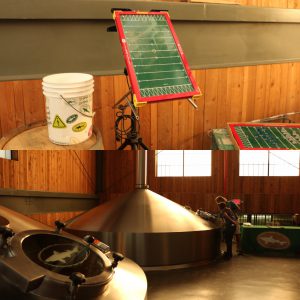
90 Minute IPA was born on a football game (top) and is now brewed in 200-barrel batches (bottom).
The vibrating football game broke after a few batches (its electronic parts weren’t meant to be held over a steaming kettle), but the idea for continual hopping lives on. Today, the ka-woosh sound of a pneumonic cannon shooting fistfuls of hops into 200 barrels of boiling wort echoes through the wood-paneled brewhouse every few minutes. That’s the sound of innovation in the off-centered way that Dogfish Head loves.
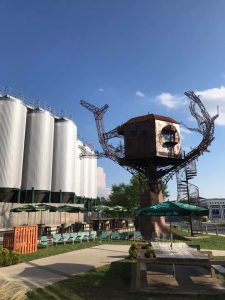
Dogfish Head Brewery welcomes visitors with a steampunk treehouse and 1200-barrel tanks outside its Milton, Delaware brewery.
The Dogfish Head idea train
While Dogfish Head initially made their reputation on 60, 90, and 120 Minute IPAs, those beers were just the breakout beers for this enterprising young brewery. The Dogfish Head idea train kept rolling and picked up steam along the way. Sam admits that innovating gets harder every year when you have so many bright bulbs in the American craft brewing industry. “With 7,000 breweries and most of them looking for creative ideas, it gets harder and harder to find white space where no one else is playing,” Sam explains. For example, Sam points to naming new beers. “10-15 years ago, I wouldn’t have to think about it. Oh, Raison d’Etre. No one else is going to use that crazy name! And now, today, we come up with a great name and you enter that word with the word ‘beer’ after it on Google and press enter and hope for the best, but odds are that some tiny little brewery in Spokane or Austin, Texas is thinking of that same name. So, coming up with names, let alone recipes that are unique and viable and exciting is hard.”
For Dogfish Head, staying faithful to their creative muse becomes increasingly challenging but vitally important. Sam tells his co-workers who are working on the latest round of off-centered ales, “don’t copy anybody.” Sam is explicit about his desire to remain original or keep working. “Try to come up with our own inspirations. There are a lot of breweries who made a good run of it for 10, 20, sometimes 25 years by being fast followers. You can just draft (in the bicycling sense) behind the leaders and make a living out of being a fast follower, but that has never really excited me.” Sam candidly admits, “I would rather we take risks and go for it and do some exotic things. Sometimes they don’t work and sometimes they work.” He points to a few examples like “in the case of Piercing Pils, we made a beautiful crisp pilsner with pears, but we decided to do it as a winter beer, and it turns out people don’t really want to drink a pilsner when its ten degrees in New England. That one didn’t sell well, so we hiatused it.” Experimentation has its upside, too, and while not every beer may be a home run, the road to the company fastest-growing beer was paved with test batches and chances taken.
The best-selling beer in the company’s history came from innovation – a collaboration beer with the National Aquarium. “With SeaQuench Ale, five years ago if you tried to say ‘Hey, I’m going to make 40-50,000 bbls of a beer that’s a mashup of a kolsch, a Berliner Weiss, and a gose with black limes and sea salt, people would have thought you were crazy, but now it’s the fastest-growing beer in the history of our company.” Looking for innovations has been the path that Dogfish Head has carved for itself and Sam wants the brewery to keep going down that path.
Sam feels that SeaQuench’s multilayered appeal is key to inviting new drinkers to the world of great beer. “We know that we have a winner in SeaQuench and especially in a hot climate like Florida, we see that SeaQuench will be a viable year-round beer since it appeals to margarita drinkers and pinot gris drinkers alike.” Sam says he sees long-term success with SeaQuench, and the brewery is going to continue to bet on it. “I think the runway is super long for SeaQuench, so I think in 2019 we’re going to do a complimentary beer very different from SeaQuench sour that we think will do really really well.” Sam says that Florida can expect to see this new beer from April through the summer as long as it lasts.
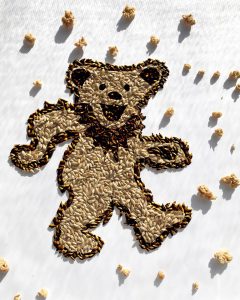
Dogfish Head has only hinted at their next collaboration. No definitive news yet…
Being one with the music while marching to their own drummer
Each year, Dogfish Head supports Record Store Day, a day celebrating independent record stores nationwide. In recent years, that support has included collaborations with well-known musicians. Sam prefers collaborations that have a “karmic resonance” – when brewer and music-maker each contribute their talents to the project. As an example, 2018’s collaborator was Flaming Lips frontman, Wayne Coyne. Coyne was so inspired by the project that he wrote two original songs for the project. The beer that resulted from the collaboration, called Dragons & Yum-Yums, was part of the brewery’s Art Series in 2018 and has a rumored return in the future.
The next collaboration is already in the works, and Sam says the drinking public will find out soon. “We have a love for music as much as for beer, so without giving too much away, they’ll be a big announcement of a really internationally famous band that’s famous with a few different generations that we’ll be doing something with next year.” This spirit of collaboration is not just limited to national bands. “We’ll be doing stuff with more local indy bands as well – lower profile but still super cool. We’re going to still go hard at the music front.”
What’s after IPA?
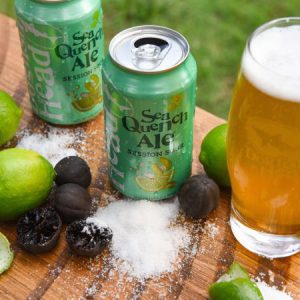
Dogfish Head’s SeaQuench, brewed with black limes and sea salt, is the fastest-growing beer in company history.
Despite his success with 60 Minute, 90 Minute, and 120 Minute IPA, Sam thinks long and hard about what beer could replace IPA in the hearts and minds of beer drinkers. When asked ‘what’s after IPAs,’ Sam furrows his brow and says, “IPAs are what’s after IPAs.” We’re a bunch of wily vets in this room, so we think everyone is getting sick of IPAs. As we all know, independent craft beer still has less than 13% market share, so 87% of the folks out there drinking beer are hopefully getting interested in craft and with IPAs, there’s never been so galvanizing or scalable a style in the 35-year history of the craft brewing renaissance as IPAs.” Part of the beauty of the style is how many different nuanced flavors it can accentuate. “That being said, the fragmentation of the IPA styles is going to accelerate as some sections from session IPAs to fruited IPAs to New England IPAs get more traction and get more dynamic.” Sam believes that the IPA style has so many facets and layers that it will continue to be the most favored beer style among beer enthusiasts for years to come.
More than a fishing story
As Dogfish Head continues to grow and size up, Sam says that the brewery’s current size “feels right.” While his 200-barrel brewhouse is considerably larger than the seven-barrel brewery Sam had previously aspired to, the scale of the brewery fits with its current portfolio and the number of beers that resonate with the beer-loving public. Sam reflects, “here we are in a room with our original half-barrel system on one side and our 200-barrel system on the other. This equipment is surreal to me, how big it is, but it doesn’t feel wrong or awkward, it still feels right.” Sam admits that he is not overwhelmed by how big the brewery is because of the organic growth it took to get there. “I would be freaked out if we got to the scale that we are and only made 60-minute IPA. But the fact that there are tanks outside that hold 1,200 barrels of beer and some of them are filled with Punkin Ale, some of them are filled with SeaQuench, some of them are filled with Flesh and Blood, some are filled with 60 Minute, it feels right to me that we got this big because we didn’t have to change our business model and our off-centered approach to brewing to get to this size.”
Sam smiles at the impact that Dogfish’s love of culinary ingredients and off-centered approach has had on the beer industry as a whole. “We were the original that said in our business plan that the majority of beers we make will be made with culinary ingredients and that was true when we were the smallest brewery in America and it’s still true today when we’re a top 12 brewery. The majority of the recipes that come out of this building are made with culinary ingredients.” While the winds of change have blown through the entire brewing industry in recent years, Sam says he’s proud of the way Dogfish Head has grown. “If anything, the brewing industry bended towards what we were doing, which was being more creative, more flavor-forward, more adventurous with our flavor profiles. The scale is admittedly big for an independent craft brewery, but it still feels right, still feels good.”
More than beer: Dogfish Head’s mission
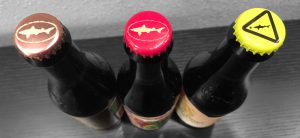
Dogfish Head’s 60 Minute IPA, 90 Minute IPA, and 120 Minute IPA (from left to right).
While all of the beer Dogfish Head has made continues to open minds about craft beer, Sam says that his biggest point of pride in the company is how the mission has evolved to its current state. “We’re really proud of the fact that (as a company) we’re about people first and product second. Our mission statement is: We are off-centered goodness for off-centered people.” Dogfish Head may have grown beyond its original location, but the company works hard not to forget its roots, Sam insists. “That mission statement serves to remind everyone that it’s the people that make Dogfish Head special, not the equipment or the recipes first.”




